![]()
![]()
![]()
Use LEFT and RIGHT arrow keys to navigate between flashcards;
Use UP and DOWN arrow keys to flip the card;
H to show hint;
A reads text to speech;
155 Cards in this Set
- Front
- Back
|
What body landmark describes the cheek? |
Buccal |
|
|
What body landmark describes the fingers? |
Digital |
|
|
What body landmark describes the shoulder blade region? |
Scapular |
|
|
What body region describes the anterior aspect of the knee? |
Patellar |
|
|
What body aspect describes the heel of the foot? |
Calcaneal |
|
|
What body landmark describes the head? |
Cephalic |
|
|
Which body areas are appendicular? |
Antecubital, Brachial, Crural, Femoral, Fibular, Popliteal, and Sural |
|
|
Which body areas are axial? |
Abdominal, Cervical, Gluteal, Lumbar, Occipital, Oral, Pubic, Thoracic, and Umbilical |
|
|
What is the plasma membrane and what is its function? |
A fluid-mosaic lipid bilayer (phospholipids, cholesterol, and glycolipids) studded with proteins surrounds cytoplasm.
Function: protects cellular content; makes contact with other cells; contains channnels, transporters, receptors, enzymes, cell0identity markers, and linker proteins; mediates the entry and exit of substances. |
|
|
What is the cytoplasm and what is its function? |
Cellular contents between the plasma membrane and nucleus-cytosol and organelles. Function: Site of all intracellular activities except those occurring in the nucleus. |
|
|
What is cytosol and what is the function? |
Contains cytoskeleton, a network of three types of protein filaments: microfilaments, intermediate filaments , and microtubules. Function: Fluid in which many of cell's metabolic reactions occur. Cytoskeleton maintains shape and general organization of cellular contents; responsible for cellular movements. |
|
|
What is an organelle and what is its function? |
Specialized structures with characteristic shapes. Function: Each organelle has specific functions. |
|
|
What is a centrosome and what is its function? |
A pair of centrioles plus pericentriolar material. Function: The pericentriolar material contains tubulins, which are used for growth of the mitotic spindle and microotubule formation. |
|
|
What is cilia and flagella and what is its function? |
Motile cell surface projections that contain 20 microtubules and a basal body. Function: Cillia moves fluids over a cell's surface; flagella move an entire cell. |
|
|
What is a ribosome and what is its function? |
Composed of two subunits containing ribosomal RNA and proteins; may be free in cytosol or attached to rough ER. Function: Protein synthesis. |
|
|
What is endoplasmic reticulum (ER) and what is its function? |
Membranous network of flattenedsacs or tubules. Rough ERis covered by ribosomes and is attached to the nuclear envelope; smooth ER lacks ribosomes. Function: Rough ER synthesizes glycoproteins and phospholipids that are transferred to cellular organelles, inserted into the plasma membrane, or secreted during exocytosis. smooth er synthesizes fatty acids and steroids; inactivates or detoxifies drugs; removes the phosphate group from glucose-6-phosphate; and stores and releases calcium ions in muscle cells. |
|
|
What is the Golgi Complex and what is its function? |
Consists of 3-20 flattened membranous sacs called cisternae; structurally and functionally divided into entry face, medial cisternae and exit face. Function: Entry face accepts proteins from rough ER; medial cisternae form glycoproteins, glycolipids, and lipoproteins; exitfade modifies the molecules further, then sorts and packages them for transport to their destinations. |
|
|
What is a lysosome and what is its function? |
Vesicle formed from Golgi complex; contains digestive enzymes. Function: Fuses with and digets contents of endosomes, phagosomes, and vesicles formed during bulk-phase endocytosis and transports final products of digestion into cytosol; digests worn-out organelles, entire cells, and extracellular materials. |
|
|
What is a peroxisome and what is the function/ |
Vesicle containing oxidases and catalase; new peroxisomes bud from preexisting ones. Function: Oxidizes amino acids and fatty acids; detoxifies harmful substances such as hydrogen peroxide and associated free radicals. |
|
|
What is a proteasome and what is the function? |
Tiny barrel-shaped structure that contains proteases. Function: degrades unneded, damaged, or faulty proteins by cutting them into small peptides. |
|
|
What is the Mitochondrion and what is its function? |
consists of an outer and an inner mitochondrial membrane, cristae, and matrix; new mitochondria form from preexisting ones. Function; Site of aerobic cellular respiration reactions that produce most of a cell's ATP and play an important early role in apoptosis. |
|
|
Which body system rids the body of nitrogen-containing wastes? |
Urinary |
|
|
What are the 11 systems of the human body? |
Cardiovascular, Lymphatic, Nervous, Endocrine, Respiratory, Digestive, Urinary, Reproductive, Integumentary, Skeletal, and Muscular. |
|
|
Name 2 systems: What are their components and what are their functions? |
SKELETAL SYSTEM: Components: Bones and joints of the body and their associated cartilages. Functions: Supports and protects the body; provides surface area for muscles to attatch; aidy body movements; houses cells that produce blood cells; stores minerals and lipids.
MUSCULAR SYSTEM: Components: Refers to skeletal muscle tissue; muscle usually attatched to bone (other muscle tissues include smooth and cardiac) Function: Participates in bringing about body movements, such as walking, maintains posture, and produces heat. |
|
|
Which body system is affected by removal of the thryoid gland? |
Endocrine |
|
|
Which body system provides support and levers on which the muscular system acts? |
Skeletal |
|
|
Which system includes the heart? |
Cardiovascular |
|
|
Which system protects the body; destroys bacteria and tumor cells? |
lymphatic/immune |
|
|
Which system breaks down ingested food into its building blocks? |
Digestive |
|
|
Which system removes carbon dioxide from the blood? |
Respiratory |
|
|
Which system delivers oxygen and nutrients to the tissues? |
Cardiovascular |
|
|
Which system moves the limbs; facilitates facial expressions? |
Muscular |
|
|
Which system conserves body water or eliminates excesses? |
Urinary |
|
|
Which systems facilitate conception and childbirth? |
Endocrine and reproductive systems |
|
|
Which system controls the body by means of chemical molecules called hormones? |
Endocrine |
|
|
Which system is damaged when you cut your finger or get a severe sunburn? |
integumentary |
|
|
What system are the thymus, spleen, and lymphatic vessels a part of? |
Lymphatic/immune |
|
|
What system are bones, cartilages, and tendons a part of? |
Skeletal |
|
|
What system is the pancreas, pituitary, and adrenal glands in? |
Endocrine |
|
|
Which system is the epidermis, dermis, cutaneous sense organs a part of? |
Integumentary |
|
|
What system is the testis, ductus deferens, urethra a part of? |
Reproductive |
|
|
What system is the esophagus, large intestine, and rectum a part of? |
Digestive |
|
|
What system is the muscles of the thigh and the postular muscles a part of? |
Muscular |
|
|
What body cavity is the stomach in? |
Abdominopelvic |
|
|
What body cavity is the esophagus in? |
Thoracic |
|
|
What body cavity is the liver in? |
Abdominopelvic |
|
|
What body cavity is the spinal cord in? |
Spinal |
|
|
What body cavity is the urinary bladder a part of? |
Abdominopelvic |
|
|
What body cavity is the heart a part of? |
Thoracic |
|
|
What body cavity is the trachea a part of? |
Thoracic |
|
|
What body cavity is the rectum a part of? |
Abdominopelvic |
|
|
What organs are in the hypogastric region? |
Large intestine, urinary bladder, and rectum |
|
|
What organ is in the right lumbar region? |
Large intestine |
|
|
What organ is in the umbilical region? |
Large intestine |
|
|
What organs are in the epigastric region? |
Stomach, large intestines, and liver |
|
|
What organs are in the left hypochondriac region? |
Stomach and large intestines |
|
|
What are the levels of organization of a living body? |
*Chemicals *Cells *Tissue *Organ *Organ System *Organisms |
|
|
What is an organ? |
A body part (or structure) that is made up of two or more tissue types and performs a specific body function. |
|
|
Why is it helpful to study the external and internal structures of the rat? |
Many of the external and internal structures are similar to those in the human. Studying the rat can help you to understand your own structure. |
|
|
What is the name of the muscle that subdivides the ventral body cavity? |
Diaphragm |
|
|
What are the bony landmarks of the abdominopelvic cavity? |
Dorsally, the vertebral column; laterally and anteriorly, the pelvis |
|
|
Which body cavity affords the least protection to its internal structures? |
Abdominal |
|
|
What is the function of the serious membranes of the body? |
The serous membranes produce a lubricating fluid that reduces friction as organs slide across one another or against the cavity walls during their functioning. |
|
|
A nurse informs you that she is about to take blood from the antecubital region. What portion of you body should you present her? |
The arm; the anterior surface of the elbow joint. |
|
|
What cavity holds the eyes in an anterior-facing position? |
Orbital cavity |
|
|
What body cavity houses three tiny bones involved in hearing? |
Middle ear cavity |
|
|
What body cavity is contained within the nose? |
Nasal cavity |
|
|
What body cavity contains the tongue? |
Oral Cavity |
|
|
What body cavity surrounds a joint? |
Synovial cavity |
|
|
What body cavity is contained within the skull and vertebral columns? |
Dorsal body cavity |
|
|
What body cavity houses female reproductive organs? |
Pelvic cavity |
|
|
What is the most protective body cavity? |
Dorsal body cavity (cranial or spinal cavity) |
|
|
What body cavity's name means "belly" |
Ventral body cavity |
|
|
What body cavity contains the heart? |
Thoracic |
|
|
Which body cavity contains the small intestine? |
Abdominopelvic or Abdominal |
|
|
Which body cavity is bounded by the ribs? |
Thoracic |
|
|
Which body cavity's walls are muscular? |
Abdominal |
|
|
What body cavity would have to be opened to do surgery to remove a cancerous lung lobe? |
Toracic and Ventral |
|
|
What body cavity would have to be opened to remove the uterus or womb? |
Abdominopelvic and ventral |
|
|
What body cavity would have to be opened to remove a brain tumor? |
Cranial and Dorsal |
|
|
What body cavity would have to be opened to do a appendectomy? |
Abdominopelvic and ventral |
|
|
What body cavity would have to be opened to do a stomach ulcer operation? |
Abdominopelvic and ventral |
|
|
What body cavity would have to be opened to deliver of preoperative "saddle" anesthesia? |
Spinal and dorsal |
|
|
In the anatomical position, the face and palms are on the ________ body surface? |
Anterior |
|
|
The buttocks and shoulder plades are on the ________ body surface? |
Posterior |
|
|
The top of the head is the most __________ part of the body. |
Superior |
|
|
The ears are _________ and ____________ to the shoulders and ______________ to the nose. |
Medial & Superior Lateral |
|
|
The heart is ________ to the vertebral column and ____________ to the lungs. |
Anterior Medial |
|
|
The elbow is _________ to the fingers but _______________ to the shoulders. |
Proximal; Distal |
|
|
The abdominopelvice cavity is ______________ to the thoracic cavity and ___________ to the spinal cavity. |
Inferior; Anterior |
|
|
In humans, the dorsal surface can also be called the __________ surface, however, in quadruped animals, the dorsal surface is the ____________ surface. |
Posterior; Superior |
|
|
If an incision cuts the heart into right and left parts, the section is a ______________ section; but if the heart is cut so that superior and inferior portions result, the section is a _________ section. |
Sagittal; Transverse |
|
|
You are told to cut a dissection animal along two planes so that both kidneys are observable in each section. The two sections that will always meet this requirement are the __________ and __________ sections. |
Frontal and transverse |
|
|
A section that demonstrates the cintinuity between the spinal and cranial cavities is a ____________ section. |
Sagittal |
|

What body area is A? |
Abdominal |
|
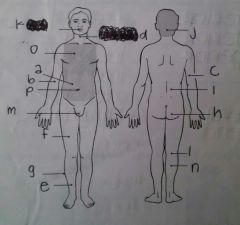
What body area is B? |
Antecubital |
|
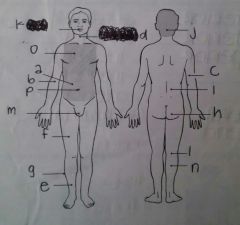
What body area is C? |
Brachial |
|
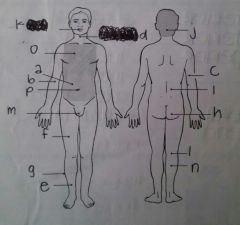
What body area is D? |
Cervical |
|
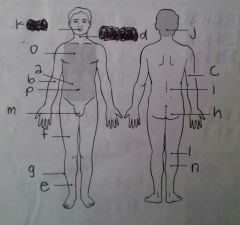
What body area is E? |
Crural |
|
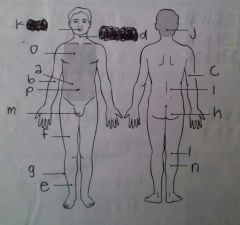
What body area is F? |
Femoral |
|
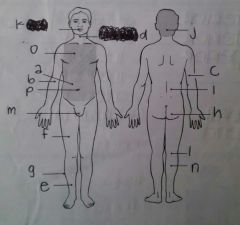
What body area is G? |
Fibular |
|
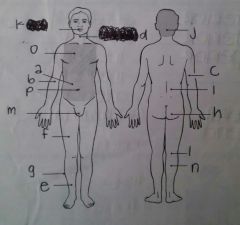
What body area is H? |
Gluteal |
|
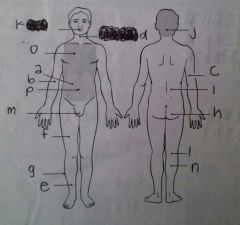
What body area is I? |
Lumbar |
|
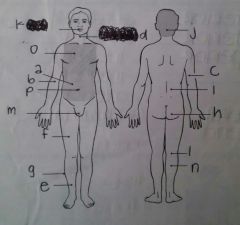
What body area is J? |
Occipital |
|
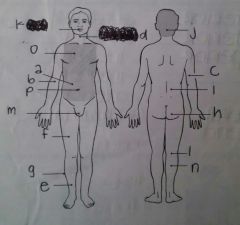
What body area is K? |
Oral |
|
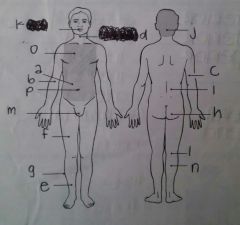
What body area is L? |
Popliteal |
|
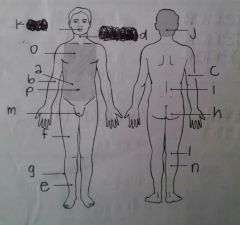
What body area is M? |
Pubic |
|

What body area is N? |
Sural |
|

What body area is O? |
Thoracic |
|
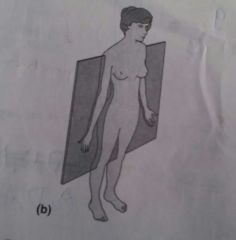
What body plane is this? |
Frontal Plane |
|

What body plane is this? |
Transverse plane |
|
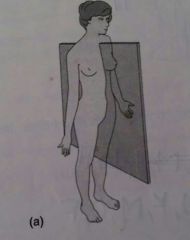
What body plane is this? |
Median midsaggital plane |
|
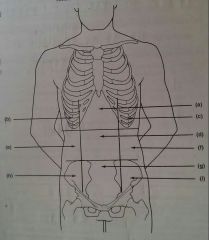
What region is A? |
Epigastric region |
|
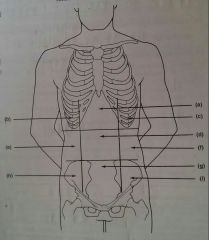
What region is b? |
Right hypochondriac region |
|
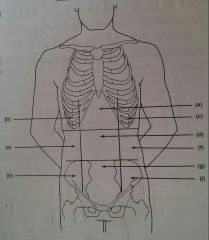
What region is c? |
Left hypochondriac region |
|
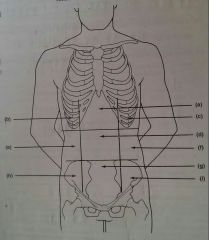
What region is d? |
Umbilical region |
|
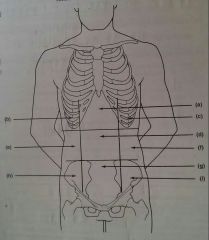
What region is E? |
Right lumbar region |
|
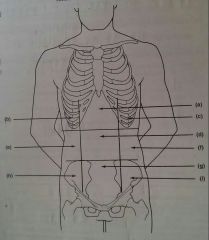
What region is F? |
Left lumbar region |
|
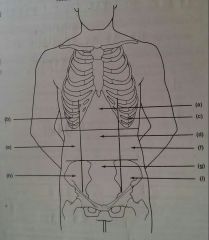
What region is g? |
Hypogastric region |
|
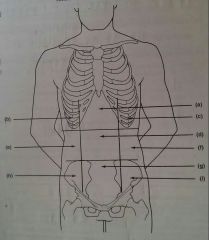
What region is h? |
Right iliac region |
|
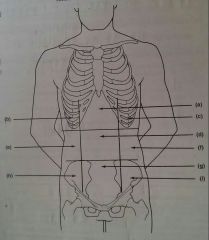
What region is i? |
Left iliac region |
|

What is A? |
Brain |
|
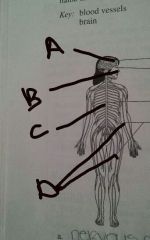
What is B? |
Sensory Receptor |
|
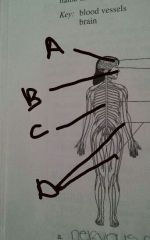
What is C? |
Spinal Cord |
|
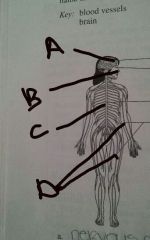
What is D? |
Nerves |
|
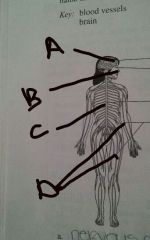
What system is this? |
Nervous System |
|
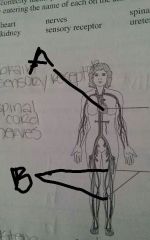
What is A? |
Heart |
|
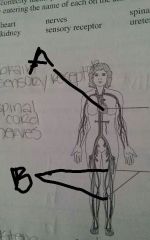
What is B? |
Blood vessels |
|
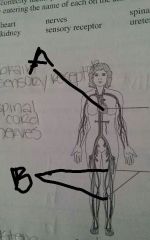
What system is this? |
Cardiovascular System |
|
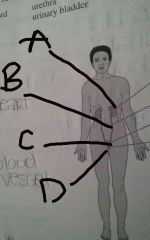
What is A? |
Kidneys |
|

What is B? |
Ureters |
|
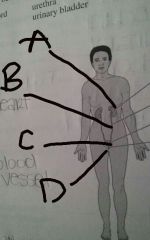
What is C? |
Bladder |
|
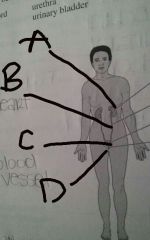
kWhat is D? |
Urethra |
|
|
What is an atom? |
The smalles units of matter that participate in chemical reactions. |
|
|
What is a molecule? |
Two or more atoms joined together. |
|
|
What atoms are essential for life? |
C, H, O, N, P, and Ca. |
|
|
What are some examples of connections between structure and function in the human body? |
Tight connections between the bones of the skull which protect the brain and fingers of the hand are more Loosely jointed to provide movement such as playing an instrument grasping a baseball bat or reaching a small object from the floor, the shape of the external ear assist in the connection and localization of sound waves which facilitates hearing |
|
|
Which body systems help eliminate wastes? |
The integumentary system, the cardiovascular system, the digestive system, and the urinary system |
|
|
What is the anatomical position and why is it used? |
In anatomy the anatomical position is a standard position of reference for the description of anatomical structures. In the anatomical position, the subject stands erect facing the Observer, with the head level and the eyes facing directly forward. The lower limbs are parallel and the feet flat on the floor and directed forward. The upper limbs are at the sides with the Palms facing forward. With the body in the anatomical position, it is easier to visualize and understand its organization into various regions and describe relationships of various structures. |
|
|
Which of the planes that divide the body are vertical? |
The frontal plane, parasagittal plane , midsagittal plane and sagittal plane |
|
|
Which directional terms can be used to specify the relationship between(1) the elbow and the shoulder, (2)the left and right shoulders, (3)the sternum and the humerus and(4) the heart and the diaphragm |
The elbow is inferior to the shoulder , the right and left shoulder are contralateral to each other, the humerus is lateral to the sternum, the heart is superior to the diaphragm |
|
|
What is a cell? |
Structures composed of chemicals and are the basic structureal and functional units of an organism. |
|
|
Describe the contents of the mediastinum |
The mediastinum is an anatomical region that is between the lungs and extends from the sternum to the vertebral column and from the first rib to the diaphragm. It contains the heart and the vertebral column and the thymus, as well as the pericardial cavity |
|
|
What type of movements can occur in the human body? |
* Motion of the whole body * Individual organs * Single cells * Structures inside cells |
|
|
Classify each of the following as a sign or symptom: high blood pressure, fever, headache, rapid pulse. |
High blood pressure is a symptom , fever is a sign , headache is a symptom, rapid pulse is a sign |
|
|
What is the difference between a plane and a section? |
Planes are imaginary flat surfaces that pass through the body. A section is a cut of the body ore one of its organs made along one of the planes. |
|
|
What kind of Medical Imaging technique that reveals the physiology of a structure? |
MRI |
|
|
After stopping at the scale, and your roommate complains that she gained 453.6 grams since the beginning of the semester. How much weight did she gain in pounds? |
1 pound |
|
|
What structures separate the various body cavities from one another? |
* Diaphragm separates the thoracic cavity from abdominopelvice cavity. * No walls separate abdominal and pelvic cavities. * Cranial cavity and vertebral cavity are continuous |
|
|
Which forms of medical imaging would be used to show a blockage in an artery of the heart? |
Angiogram or CCTA |
|
|
Which medical imaging technique would you use to determine whether a bone was broken? |
X-ray |
|
|
Eight-year-old Taylor was going for the record for the longest upside-down hang from the monkey bars. She didn't make it and she may have done extensive damage to her entire upper limb. The emergency room technicial would like an x-ray of her arm in the anatomical position. Use the proper anatomical terms to describe the position of Taylor's arm, forearm and hand in the x-ray. |
Anterior x-ray of the brachial, antebrachial, and manual body regions. |
|
|
Your anatomy professor displays an MRI scan that shows a parasagittal section of the torso taken through the midpoint of the left mammary gland. Name 5 organs you would expect to see in this image. |
Colon, Large intestines, Stomach, Liver, and spleen. |
|
|
Describe the general features of the three main parts of a cell. |
* Plasma membrane: Cell's flexible outer surface. Seperates internal environment for the cell's external environment. * Cytoplasm: All of the cellular contents between the plasma membrane and the nucleus. Made up of cytosol (fluid portion) and organelles. * Nucleus: Large organelle that has most of the cell's DNA. Chromosomes hold thousands of genes. |
|
|
Distinguish integral proteins from peripheral proteins. |
Integral proteins extend into or throught he lipid bilayer and are firmly embedded in it. Peripheral proteins are not as firmly embedded in the membrane and are attached to membrane lipids or integral proteins at inner or outer surface. |

